Page
16: Farewell
to Whitehorse
During
our visit to Dawson City we returned each evening to our tent in the
campsite. The nights were cold for camping, and we were grateful for
the warmth of our pressure lamp, which helped to make the tent a little
cosier. Soon it was time to leave Dawson City, return to Whitehorse,
and then start off on the long journey back to the south and Manitoba.
We
decided to take an indirect, longer route to Winnipeg, camping along
the way, to see some more of beautiful British Columbia. We would
visit Vancouver, Victoria, and Vancouver Island. Driving back through
the rain along the winding road to Whitehorse, we checked in at the
Chilkoot Motel. Our friends and neighbours, the Grahams, offered hospitality
in the form of meals and laundry facilities, both of which were much
appreciated after our rather rainy camping trip!
We bid a final farewell to our friends and then we were off on the
road back to the south. But we left Whitehorse with an addition to
our family, and the best possible souvenir we could have of our stay
in the Yukon - Trixie.
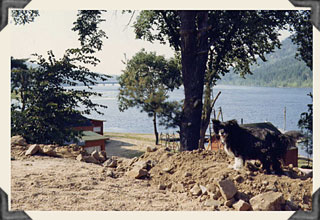
Trixie
At
each overnight stop on our trip north along the Highway, I had read
to the children as they settled down for the night in their sleeping
bags. The book I had chosen as the most appropriate for our trip was
White Gold in the Cassiar, by W.G. Crisp. The hero of the book was
a boy whose closest companion was a Tahltan Bear Dog from Cassiar,
in northern BC. The children decided they would dearly love to have
a Bear Dog for a pet, so our first project when we reached Whitehorse
was to see whether it was possible to find one.
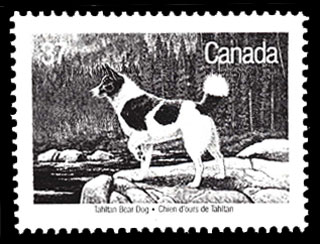
Bear Dog: Canada Post 37-cent stamp
When
we got to Whitehorse, we were surprised to find that these dogs had
become very rare indeed, and that most southern authorities had decided
they had become extinct around 1940. They were bred by the Tahltan
Indians of the Stikine River, who used them in pairs for hunting bear.
It was said that a pair of dogs could keep a bear in one place for
forty-eight hours until the hunters could catch up to them. The strategy
used was for one of the dogs to attack the bear from behind, nipping
at its feet and legs until the bear turned around to rid itself of
the attacker. Immediately the other dog of the pair, now behind the
bear, would begin to nip at its hind feet. As the bear, confused,
continued turning to face each of its attackers, it was kept in the
same place as long as the dogs could keep up their manoeuvres.
One
of Dick's staff, having heard of his quest, told him that he had seen
a Bear Dog in the pet section of a shop downtown, Mac's News Stand,
which sold magazines, newspapers, comics, and pets. The little dog
in the store had an interesting history. A retired engineer, living
some way out of town, had been taken sick, and his removal to hospital
had left his collection of animals to roam where they pleased. They
became a nuisance in the area and the keeper of the town dog pound
had been sent to round them up and dispose of them.
The
pound keeper was able to capture most of the animals but had great
difficulty in catching the Bear Dog. Finally he managed to do so by
setting a drop trap, which would catch but not harm her, and baiting
it with food. When he looked at her in the pound, he couldn't bear
to shoot her, so he placed her in the shop's small pet section, hoping
that someone might adopt her. We were, of course, absolutely delighted
to do so, and Trixie (the name somehow seemed to suit her better than
a "northern" name) became part of the family from then on.
She was a delightful little dog and soon became very protective of
our family, which she obviously considered to be part of her pack.
No
matter what the time of year, people could swim in the delightfully
warm thermal waters of the Takhini Hot Springs open-air pool, which
was twenty miles from Whitehorse along the Mayo-Dawson City highway.
There we saw another Bear Dog, which was owned by the pool manager.
She was a charming bitch, and her proud owner had named her Elizabeth
Taylor, because, he said, she was so beautiful.
There
seemed to be two sorts of Bear Dog in the Yukon, the longhaired and
the shorthaired varieties. Trixie was one of the longhaired kind,
and Elizabeth Taylor was one of the shorthaired, sleeker sort. Both
kinds were well-known in the Yukon, and when local inhabitants saw
Trixie, they immediately recognized her breed and congratulated us
on having her. At Pelly River Crossing, where we stopped to have a
flat tire fixed on the way back from Dawson City to Whitehorse, the
owners of the garage there were fortunate enough to possess a Bear
Dog, a male called Andy; another male, with a crippled leg, lived
in Camp Takhini
Visiting
the National Museum of Natural History in Ottawa a year or two later,
we were amazed to find a stuffed Bear Dog in a glass case, labelled
"extinct." We pointed out to the curators that, not only
was it not extinct, we had a live one in the car outside! They were
most interested and gave us copies of information and some photographs
that they had in their records.
Trixie
had a black coat with a white chest, white front legs and back paws
and a touch of greyish white on her muzzle. Her coat was of coarser
long hairs over a short, thick undercoat. Her large, bat-like ears
could be pricked in several different directions, and her tail was
carried curled over her back, stretched out behind, or hanging straight
down. It was quite remarkable to see how easily she could display
how she felt by the varying positions of her ears and tail. She was
affectionate, alert, and charming, and a fast mover when she wanted
to be. She could jink so rapidly and expertly in a game of tag that
it was impossible to catch her. An energetic chaser of squirrels,
she could not distinguish her prey if it froze and stayed still, but
at any sign of movement she was off after it like a shot.
When
she first joined our family we discovered that Trixie did not know
how to bark, although she did know how to howl. But she soon learned
from the German Shepherd next door, although her first efforts were
a little peculiar - a mixture of a howl and a bark. She often joined
this friendly Shepherd in his kennel for a short nap when she felt
like it, and being an obliging sort of animal, he did not seem to
object to the invasion of his privacy!
She
also attracted the attention of the local ravens, who seemed very
interested in her. Several would stand about in the lane at the back
of the house in a sort of fascination. Perhaps it was a game, or even
an attempt at some sort of communication with her.
The
first time that we left her on her own at home, we found on our return
that she had gathered together in the middle of the living room carpet
all the shoes that she could find in the house. She was passing the
time peacefully chewing the heel of one of my as-yet-unworn new gold
evening sandals, but she was so overjoyed to see us that I could not
help but forgive her!
About
a month after she became part of the family, Trixie puzzled us by
standing in her bed shivering and looking as if something was wrong
with her. Puzzled, we called upon our neighbours who were more expert
in canine matters. Obligingly, one of them came over to see what the
matter was. After an examination he was puzzled too, but thought perhaps
she was coming into heat for the first time.
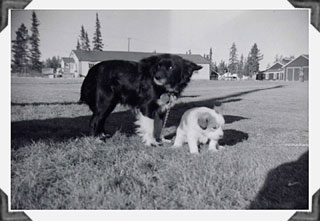
Trixie and her puppy, Coquette
A
couple of hours after he left we called him to come over and see what
had been upsetting her. She had produced a puppy, and seemed to be
quite as amazed about the whole affair as we were!
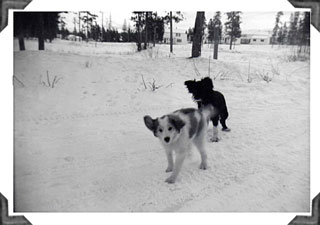
Trixie and Coquette
Trixie
was an anxious and attentive mother to the puppy, which had brown
and white markings like the Tahltan Bear Dog on the 37-cent stamp
and like Elizabeth Taylor (the dog). After she was weaned we were
able to find the puppy a good home with a truck driver who wanted
some company as he drove along the highway. He named her Coquette,
and told us later that she did a great job as a companion and a watchdog.
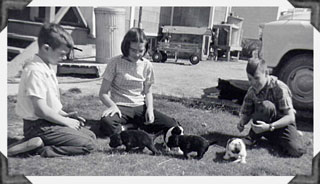
Trixie (in the background, taking a break) and her second litter
A
year later, Trixie succumbed to the attentions of an ardent black-and-tan
spaniel who had recognized, as we had not, that she was still in heat.
Now an experienced mother, she was just as conscientious with the
subsequent litter of four as she was with the first puppy. If the
puppies were outside on the lawn and she got a little tired of being
pestered by them, she would retreat to the edge of the lawn across
the street. While still keeping a wary eye on them, she was then able
to enjoy a little peace and quiet (I'm sure that every mother will
sympathize with her). The puppies would never try to cross the border
of our lawn, but would always wait for her to return. Two of them
were black - one like its mother, one like its father - and two were
marked like the Bear Dog on the postage stamp.
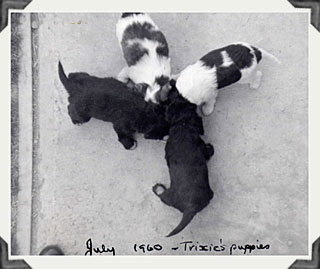
The four puppies
The puppies were all found homes after they were weaned. Each went
to its new owner with a can of their favourite dog food and, for comfort,
a piece of the blanket on which they had slept with their mother and
siblings.
The
Road South
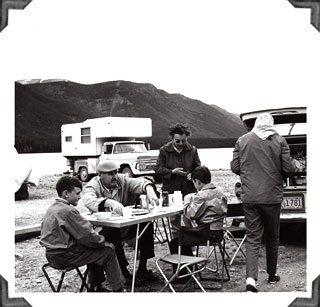
Muncho Lake, BC, July 1961: with jackets (Government Travel Bureau)
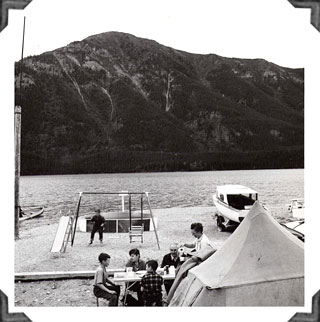
Muncho Lake, BC, July 1961: without jackets (Government Travel Bureau)
We
left Camp Takhini on a day of alternating sun and cloud. Travelling
at a leisurely pace, we took several days to reach Dawson Creek -
the end and the beginning of the Highway. On the second day of our
trip we camped at beautiful Muncho Lake, as we had done on our journey
north. While we were having breakfast the next morning, two men taking
photographs for the Canadian Government Travel Bureau asked if they
could shoot pictures of us - we were evidently "a typical tourist
family enjoying a camping trip to beautiful northern BC." After
a picture or two, they asked if we could ignore the chilly weather
and try to look as if it was really enjoyably warm. We did our best,
removing our jackets as requested, and more photographs were taken.
The team kindly signed their names in Jill's autograph book: Malak
Karsh, W. Badly, and Peter Taylor, all of Malak Studio (Malak Karsh's
brother was the famous Yousuf Karsh). They thoughtfully sent us copies
of two of the photos, one with our jackets on and one with them off.
Alas, in spite of our best efforts, it was apparent that we had utterly
failed to carry out instructions - not one of us displayed the required
carefree, comfortable basking in the sunny warmth of northern BC!
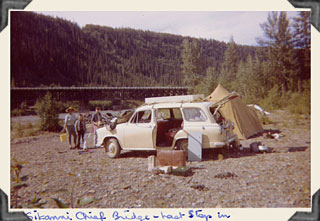
Sikanni Chief River bridge, BC, July 1961
The
following day, the weather was pleasantly sunny and fresh, and we
camped for the night beside the bridge over the Sikanni Chief River.
It was our very last overnight stop on the Northwest Highway System.
The
End of the Road
The
next day we reached Dawson Creek, the end and the beginning of the
Northwest Highway System. In the peripatetic way of army life, the
next day was the beginning of another chapter in the story of our
lives, and we travelled farther on. But not one of us will ever forget
the "true north strong and free." We will always remember
our experiences in both the Yukon and the Northwest Territories and
be grateful for the wonderful opportunities we were given to experience
the fascination of that far country, the North.
Acknowledgements
My grateful thanks are due to my daughter, Gillian Watts, who kindly
used her professional expertise to edit this account of our family
experiences in the north. Also thanks to Christopher and Ian Watts
for contributing their memories, and my son-in-law, Robert Barnett,
for scanning and computer help. And, most of all, my thanks to Michael
Martin, for his encouragement and help.
References
Used
Crisp,
W.G. "Tahltan Bear Dog," The Beaver (Summer 1956), 35-41.
Hunt,
Leonard Arthur Charles Orgar (L.A.C.O.). Rebels, Rascals & Royalty:
The Colourful North of LACO Hunt. (Yellowknife, NWT: Outcrop, 1983).
Keen,
Edward. "Brigadier-General Robert Jones. Combat engineer lived
by motto: "First in, last out," National Post, April 14,
2000, A18.
Moir,
John S., ed. History of the Royal Canadian Corps of Signals, 1903-1961
(Ottawa: Royal Canadian Corps of Signals, 1962.
Northwest
Territories & Yukon Radio System Association. Newsletter 1-3 (October
1963-October 1964).
Notes
of Interest from RCCS Radio Stations of the Northwest Territory and
Yukon Radio System 7 (June 1947); 15 (February 1948); 20-59 (July
1948-October 1951).
Whitehorse
Star 61:6 (February 9, 1961).
Yukon:
Its Riches and Romance (Ottawa: Department of Northern Affairs and
National Resources, n.d.).
--30--
Pages: [1] [2]
[3] [4]
[5] [6]
[7] [8]
[9] [10]
[11] [12]
[13] [14]
[15] [16]
Return to top of
page
Return to the Watts
Family page